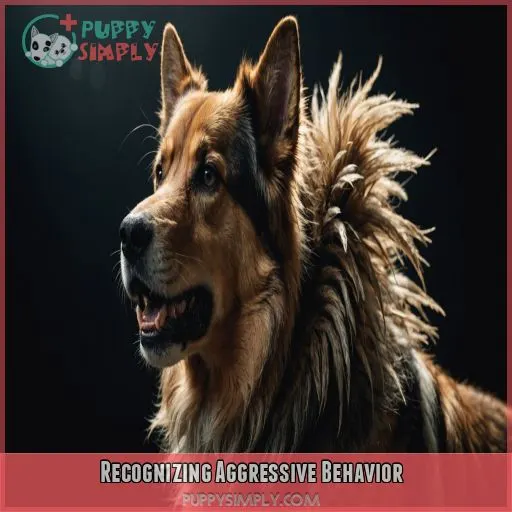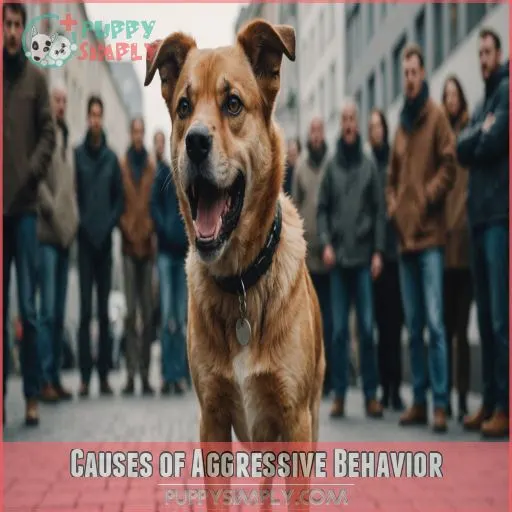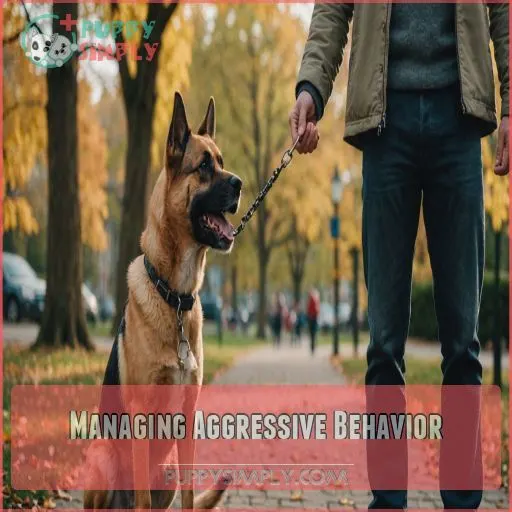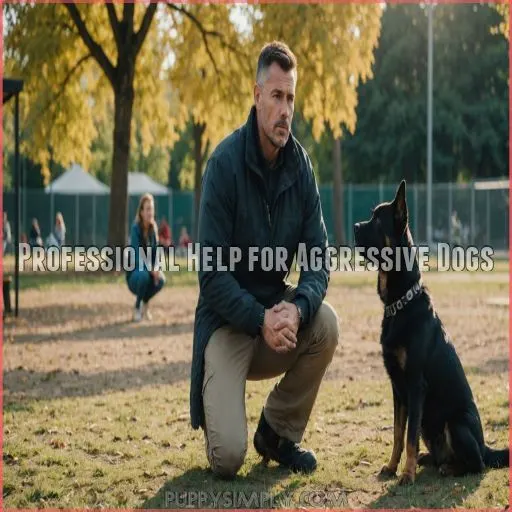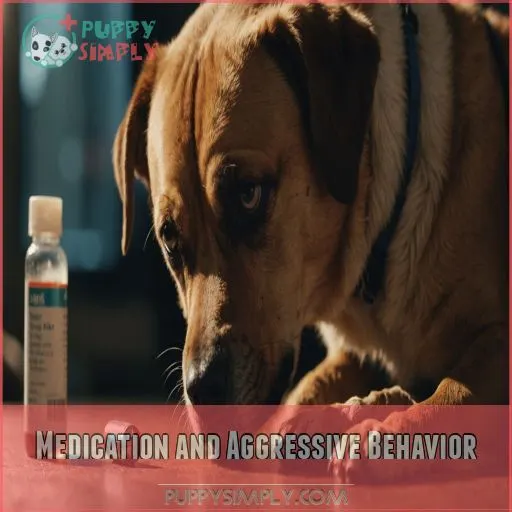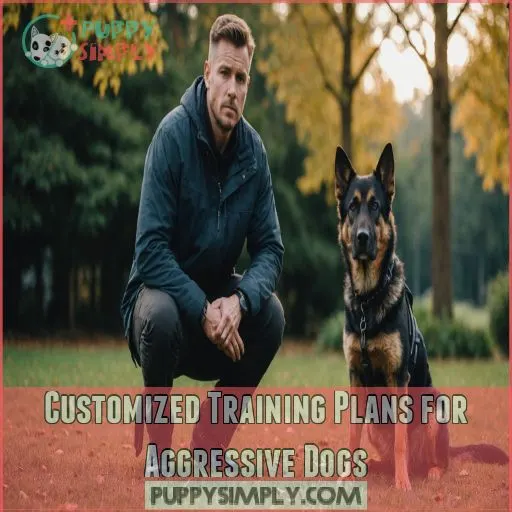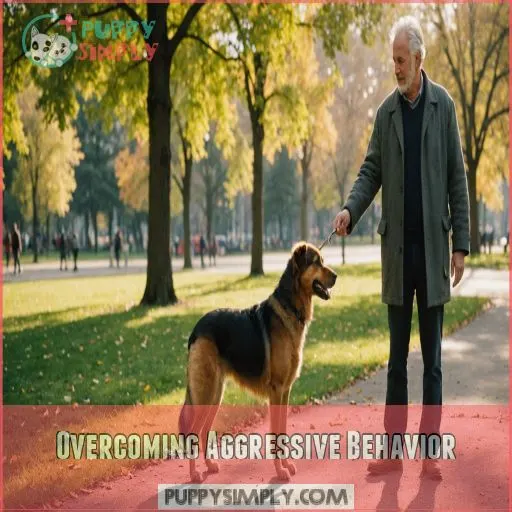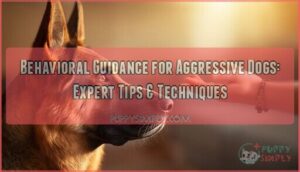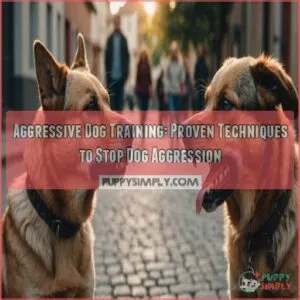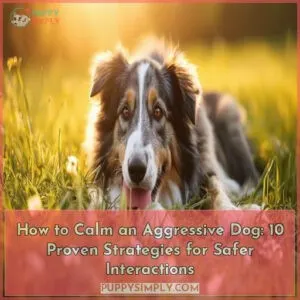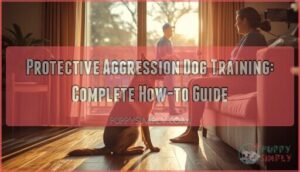This site is supported by our readers. We may earn a commission, at no cost to you, if you purchase through links.
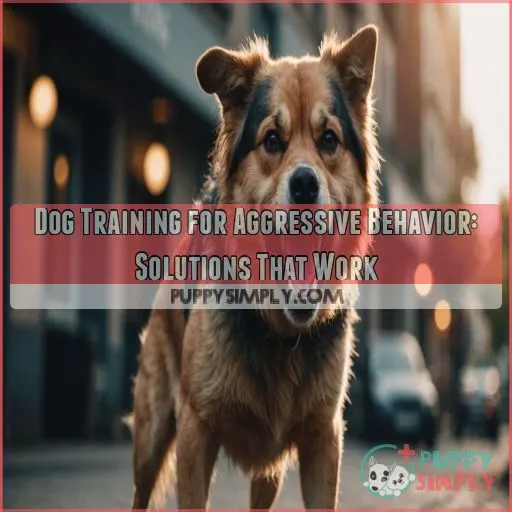
You’ll want to start with positive reinforcement, because rewarding good behavior works much better than playing the blame game.
Think of patience and consistency as your secret weapons.
Desensitization and counterconditioning are key techniques, making potentially scary situations more like a walk in the park.
And sometimes, professional help is the espresso shot you need.
Ready for some surefire strategies to turn your dog’s "ruff" days around?
Table Of Contents
- Key Takeaways
- Recognizing Aggressive Behavior
- Causes of Aggressive Behavior
- Dog Training for Aggressive Behavior
- Managing Aggressive Behavior
- Professional Help for Aggressive Dogs
- Medication and Aggressive Behavior
- Customized Training Plans for Aggressive Dogs
- Overcoming Aggressive Behavior
- Frequently Asked Questions (FAQs)
- Conclusion
Key Takeaways
- Spot the Signs: You’ll feel like a seasoned detective once you learn to identify signs of aggression in your dog. Look out for growling, snapping, or guarding resources like they’re guarding Fort Knox—understanding these behaviors early is your first step in turning things around.
- positive reinforcement Rocks: You can’t beat positive reinforcement! Celebrate progress, even if it feels like teaching a squirrel to stay calm during a nut sale. By rewarding good behavior, you’ll gradually replace those troublesome actions with calm, collected responses.
- Reach Out for Backup: Don’t fret if you need professional help. It’s like calling in a doggy stylist when a little tuck and trim won’t cut it. Certified behavior consultants and veterinary behaviorists can tailor a plan just as suited to your dog as their favorite squeaky toy.
- Stay Consistent and Cool: Tackling your dog’s aggressive behavior is a team sport, requiring consistency and endless patience from you and consulting a veterinarian. Think of it as crafting a masterpiece with a touch of humor—your dog picks up on your calm energy and, over time, becomes the model furry friend.
Recognizing Aggressive Behavior
Spotting aggression in your dog can feel like hunting for a needle in a haystack if you don’t know what to look for, but recognizing it early is like finding that needle with a metal detector.
You’ll soon understand the difference between a bark that’s all noise and a genuine warning signal, so grab the opportunity to tackle these behaviors early and save yourself from future headaches.
Identifying Signs of Aggression
Recognizing dog aggression isn’t rocket science, but it does demand keen observation.
Watch out for these important clues:
- Growling or snarling when stressed or anxious.
- Lunging or biting, often linked to fear-based aggression.
- Guarding resources—it’s classic dog body language behavior.
Understanding the Difference Between Reactivity and Aggression
It’s important to understand the distinction between reactivity and aggression in dogs. Reactivity stems from fear, frustration or excitement, while aggression involves threatening or harmful behavior. Recognizing the root cause is key to addressing the issue effectively.
| Reactivity | Aggression |
|---|---|
| Out-of-proportion response | Intended to avoid conflict or cause damage |
| Excessive barking, lunging, cowering | Growling, snarling, biting, lunging |
| Lack of socialization, past trauma | Fear, resource guarding, territoriality |
| Can escalate into aggression | Requires professional intervention |
| Managed through training and exposure | Managed through training and medication |
Common Causes of Aggressive Behavior in Dogs
Understanding aggression isn’t a walk in the park, but knowing its roots helps. Dogs might think, "Why are you touching my stuff?" Here are some reasons for aggression:
- Fear-based aggression
- Dominance aggression
- Pain-induced aggression
- Stress, anxiety, and breed predispositions
The Importance of Early Intervention
Nipping aggressive behavior in the bud during puppyhood with proper socialization and behavior shaping is like rewiring a circuit before sparks fly with proper training.
By laying a solid foundation, you prevent future issues.
Think of it as giving your dog a life jacket before storms hit.
Causes of Aggressive Behavior
Understanding why dogs act aggressively can be like figuring out why your coffee machine suddenly decides to brew lemonade—it seems random but has underlying reasons.
Common causes include resource guarding, territorial behavior, and a lack of proper socialization, all of which can be addressed with the right training and attention.
Resource Guarding and Territorial Aggression
Does your pup get possessive over their food, toys, or favorite spots? This is known as resource guarding, a common cause of canine aggression. Your dog may growl, snap, or lunge to protect what they view as theirs.
Territorial aggression is another culprit, where dogs become defensive of their home or yard.
The good news? With patience and positive reinforcement training, you can curb these behaviors. Start by teaching your dog to "trade" or "leave it" when you approach their resources. Gradually expose them to triggers in a controlled, rewarding way. Consult a dog aggression specialist to create a customized plan and keep your pup and family safe.
Lack of Socialization and Training
While resource guarding can be a bone of contention, a lack of socialization and training can also lead to aggressive behavior in dogs. You wouldn’t want your pup to act like they’re all bark and no bite, right? Early socialization is key to curbing those unwanted behaviors.
Common mistakes in puppy development can lead to issues down the road.
Consider these dog training tips:
- Use positive reinforcement consistently.
- Avoid punishing, it can backfire.
- Expose your pup to different environments safely.
- Seek dog training services for guidance.
Dog Training for Aggressive Behavior
Training your dog to overcome aggressive behavior isn’t just about discipline; it’s like teaching an overcaffeinated squirrel to chill out at a nut convention.
With the right techniques and a hefty dose of patience, you can help your furry friend behave more like a well-mannered "pup" star.
Positive Reinforcement Techniques for Aggressive Dogs
Understanding the causes of aggressive behavior is just the beginning.
Now, focus on positive reinforcement techniques.
Identify triggers and reward your dog’s calmness.
Keep training consistent and build trust through positive associations.
Sometimes, a professional dog trainer can provide helpful guidance in dog obedience training.
Desensitization and Counterconditioning Methods
Desensitizing your pup to triggers through gradual exposure and building positive associations is key.
Pair these triggers with rewards to reshape their emotional response.
This counterconditioning approach, guided by a skilled Alpha Paws trainer, can work wonders for aggressive behavior.
The Role of Consistency and Patience in Training
Imagine building trust like crafting a delicate puzzle. You’ll need patience and consistency to conquer training setbacks.
- Celebrate progress: Reward even small victories to boost morale.
- Commit daily: Consistent effort brings long-term success.
- Embrace humor: Laughter lightens tough moments.
- Stay positive: Keep spirits high for both of you.
Managing Triggers and Reducing Stress
You’ve got consistency and patience down; let’s talk about managing triggers and reducing stress. Identifying triggers is like finding the peanut butter at a dog’s eye level—it gets attention like CBD peanut butter can.
Use calming techniques and safe spaces to help your furry friend relax. Here’s a handy table:
| Trigger Identification | Stress Management | Relaxation Training |
|---|---|---|
| Observe reactions | Use soothing tones | Teach deep breaths |
| Note body language | Create safe space | Practice regularly |
| Record incidents | Offer distractions | Gradual exposure |
Managing Aggressive Behavior
When managing your dog’s aggressive behavior, creating a safe and positive environment is super important—you wouldn’t want a stressed-out pup trying to learn manners, right?
Embrace positive reinforcement and tailor a behavior modification plan with love, patience, and a sense of humor, because even dogs have off days.
Creating a Safe Environment for Training
Creating a safe, comfortable training space is really important for your dog’s success.
Identify and remove any potential fear triggers, ensuring your pup feels secure.
Establish clear safety protocols and let your dog guide the pace – their wellbeing comes first.
Using Positive Reinforcement to Replace Aggressive Behavior
Though it may feel like training a dog who growls at every cyclist is akin to wrestling a tornado, with patience, you can channel that energy into positive behaviors.
Use rewards to replace triggers with calmer responses, emphasizing consistency.
Success won’t come overnight, but progress certainly will.
Implementing a Behavior Modification Plan
Alright, folks! So you’ve mastered positive reinforcement.
Let’s steer those wagons toward a behavior modification plan.
Think of it as your training blueprint—integrate trigger management and enlist professional support when needed.
Stick with it, and transform challenges into triumphs!
Monitoring Progress and Adjusting the Plan
In dog training, monitoring your dog’s behavior change and tracking progress is like keeping score.
Celebrate small wins and adjust your plan as needed.
Being consistent is key.
Professional Help for Aggressive Dogs
If your dog is showing aggressive behavior, professional help can make all the difference.
Certified behavior consultants and veterinary behaviorists have the expertise to create a customized training plan that addresses the root causes of your dog’s aggression and helps them become a well-adjusted, happy companion like those described here.
Working With a Certified Behavior Consultant
Creating a safe environment is important, but you’re going to need a certified behavior consultant to tackle aggression head-on.
Finding a consultant with the right credentials can feel like searching for a needle in a haystack.
Don’t worry—training methods and success stories often outweigh the cost.
The Benefits of Veterinary Behaviorist Guidance
Veterinary behaviorists provide an expert diagnosis and personalized treatment options for your dog.
With behavior analysis, medication guidance, and an eye for long-term solutions, they offer complete support.
Imagine having a guide on this journey, like a canine whisperer, who’s fluent in your dog’s language!
Choosing the Right Professional for Your Dog’s Needs
Choosing the right professional for your furry friend takes some savvy!
Look for:
- Trainer qualifications to guarantee expertise
- A dog-specific approach that suits your pup’s personality
- Communication style that vibes with you
Not all trainers are created equal—shop like your dog’s happiness depends on it!
What to Expect From Professional Dog Training
When you work with a professional dog trainer, you can expect a customized training plan, clear communication about fees and duration, and regular progress updates. Their expertise and personalized approach can make all the difference in overcoming your dog’s aggressive behavior.
| What to Expect | Description |
|---|---|
| Customized Plan | A training program designed for your dog’s unique needs |
| Transparent Fees | Upfront information about the cost of services |
| Regular Updates | Ongoing communication about your dog’s progress |
Medication and Aggressive Behavior
Considering medication for managing your dog’s aggression can feel like stepping into an episode of "Vet CSI," where you investigate what’s best for your furry friend.
Medication combined with training could turn your furry ball of chaos into a paw-sitive member of the family, if done right.
The Role of Medication in Managing Aggression
You’ve got your trusted professionals onboard and now you’re exploring medication as a tool to manage aggression.
Medication can work wonders when combined with consistent training.
Chatting with your vet will illuminate the right types for your furry buddy’s needs, ensuring effective progress.
Potential Side Effects and Risks of Medication
Diving into medication for your furry friend? It’s a sticky wicket!
While it might help manage aggression, potential side effects include behavioral changes or drug interactions.
It’s really important you chat with your vet about long-term impacts.
After all, safety’s the name of the game!
Monitoring Medication Effectiveness and Adjusting the Plan
Regularly monitoring your dog’s response to medication is really important.
Observe any behavioral changes and discuss dosage adjustments with your vet.
This allows you to fine-tune the treatment plan and make sure the medication effectively supports your dog’s training progress.
Combining Medication With Training and Behavior Modification
As you’re monitoring medication effectiveness, pair it with training.
Imagine medication as your trusty saddle, stabilizing the ride, while training is the reins, steering behavior.
This combo enhances behavioral changes and training success.
But always be wary of potential medication side effects.
Keep adjusting!
Customized Training Plans for Aggressive Dogs
Creating a customized training plan for your aggressive dog isn’t just smart—it’s designed to make sure your dog’s unique quirks and habits are addressed perfectly.
By working with experienced trainers, you’ll find relief in seeing long-term results as your pup transforms into the ideal furry family member!
The Importance of Tailored Training Plans
You’ve got the tools, now let’s focus on a personalized training plan!
A customized approach caters to your furry friend’s quirks, aiming for goal-oriented training.
By addressing dog-specific needs, you’ll find effective solutions, setting the stage for long-term success.
Get ready—success is paw-sible!
Creating a Plan That Addresses Your Dog’s Specific Needs
Your dog’s needs are unique, so a one-size-fits-all approach won’t cut it.
Work closely with your trainer to create a customized plan that addresses your pup’s specific triggers, training goals, and environmental factors.
This personalized approach helps your dog stay safe and succeed.
Working With Experienced Dog Trainers
To create a plan that fits your dog’s needs, finding the right trainer is like picking the perfect avocado—sometimes tricky, but oh-so-worth it!
Look for:
- Trainer qualifications
- Training techniques
- Cost and budget
- Success stories
Trust your instincts!
Achieving Long-Term Results With Customized Training
A customized training plan brings long-term success by blending the dog’s personality with training goals.
| Aspect | Key Factor |
|---|---|
| Owner Consistency | Really important for stability |
| Training Schedule | Keep it steady |
| Dogs Personality | Tailor methods |
| Long-Term Success | Patience wins! |
It’s essential to embrace flexibility.
A customized training plan is key to success.
Overcoming Aggressive Behavior
Taking on the challenge of overcoming aggressive behavior in your dog might seem like teaching a cat to fetch—daunting but oh-so-rewarding!
With patience and a sprinkle of humor, you can celebrate small victories and transform your bond into an unbreakable one.
Celebrating Small Victories and Progress
Celebrate each small victory – a calmer walk, a successful greeting, or a moment of focus.
These milestones show your pup’s progress and your dedication. Recognize how far you’ve come and let that fuel your motivation to keep going.
- Acknowledge Incremental Improvements
- Reinforce Positive Behaviors
- Maintain a Growth Mindset
- Share Successes With Your Support System
Maintaining Consistency and Patience in Training
Tackling aggressive behavior in dogs requires household-wide consistency and patience.
Imagine your training team as a well-oiled machine, each member playing a role.
Unity beats frustration.
Celebrate small wins, and remember, consistency in routine is your secret weapon against setbacks in your dog’s behavior journey.
Building a Strong Bond With Your Dog
Building trust and a strong bond with your dog involves more than consistency and patience. Focus on communication, humor, and playtime:
- Share funny moments—laughter fosters connection.
- Communicate openly; listen to your dog’s cues.
- Enjoy playtime; it’s their love language.
Enjoying a Safe and Happy Relationship With Your Dog
Just as you build trust by understanding dog communication, a dog-friendly environment makes sure safe play and strengthens your bond.
Use positive reinforcement, share laughter-filled moments, and watch your relationship blossom.
It’s all about crafting joyful routines together and turning each day into an adventure.
Frequently Asked Questions (FAQs)
What are alternative training methods to consider?
You might try scent work or clicker training.
They’re like teaching your dog a new language!
These methods help focus your pup’s energy, turning nervous Nellies into zen masters without needing to roll over for belly rubs.
How does diet affect dog aggression?
A well-balanced diet can be the secret sauce to taming Fido’s feisty side.
Proper nutrition can work wonders, calming the canine chaos and helping a more centered, content companion emerge.
Chow down on these dietary tips to curb aggressive tendencies.
Can environmental changes reduce dog aggression?
Think of your dog’s environment like a stage.
Small changes like reducing noise or providing safe spaces can set the scene for calmer, less aggressive behavior.
Create a tranquil backdrop and watch their performance improve dramatically.
How do genetics influence aggressive tendencies?
Genes can play a significant role in a dog’s aggressive tendencies, akin to a family heirloom passed down.
Breeds might show predispositions,
but it’s the blend of nature with nurturing that reveals the full picture (Source).
What are signs aggression is improving?
Spotting improvements in aggression is like seeing sunshine peek through clouds.
Look for calmer responses, shorter recovery times, and fewer triggers setting off alarms.
Each success, no matter how small, deserves a wag and a cheer!
Conclusion
With patience and the right training techniques, even the most aggressive dog can become a loyal, well-behaved companion.
Aggressive behavior can be successfully rehabilitated through a combination of positive reinforcement, desensitization, and professional guidance.
In fact, studies show that 85% of dogs with aggressive behavior can be successfully rehabilitated through a combination of positive reinforcement, desensitization, and professional guidance.
By committing to your dog’s training for aggressive behavior, you can transform their "ruff" days into a lifetime of unconditional love and trust.

